When to Schedule Home Air Duct Cleaning Services
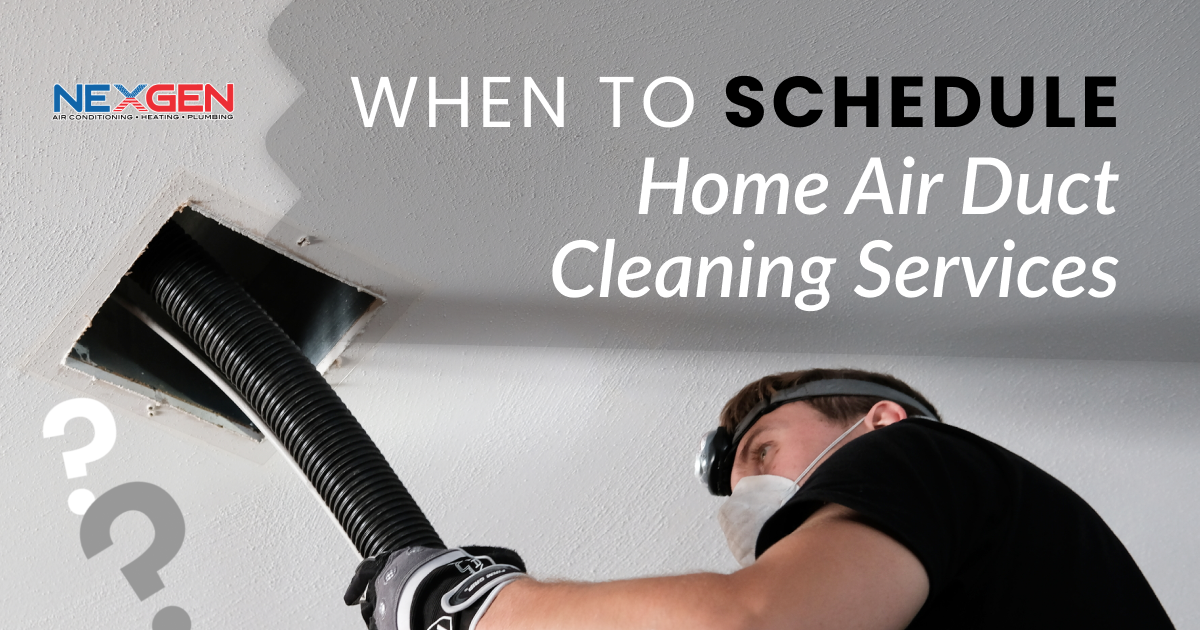
Homeowners concerned about indoor air quality are often unsure when to schedule an air duct cleaning service. Experts generally suggest it every three to five years. It’s not needed annually or more frequently like an AC tune-up, assuming you change the filters regularly and stay current with HVAC maintenance.
Many pollutants can be collected in your ductwork. Some, like smoke particles, volatile organic compounds, mold, chemicals, pesticides, etc., can be harmful. Contamination may also reduce HVAC performance and efficiency. Therefore, following our advice for scheduling air duct cleaning services can be beneficial.
When Is Best to Consider Air Duct Cleaning?
Since there’s no solid guideline on when to clean air ducts, it can be difficult to know when to call a contractor. But requesting the help of a ductwork professional is a good idea if:
- Your Ductwork Has Never Been Cleaned: Perhaps it’s been years, or decades, since your air ducts were installed, or they haven’t been professionally cleaned since you moved into your home. We suggest at least scheduling an inspection to see if your ducts are dirty.
- You’ve Recently Renovated/Remodeled Your Home: Dust and debris easily become airborne during renovation or remodeling work and can be blown into air ducts. Once inside, contamination can build up and recirculate.
- There’s Construction Near Your Home: Construction creates dust and particles that can find their way into your home and HVAC ducts. If your home is near a construction site, consider having your air ducts checked, and if necessary, cleaned.
- High Air Pollution Affects Your Area: Polluted air can contain particulates, smoke, and chemicals that can enter your home in many ways. If your city or community often experiences low air quality, consider more frequent duct cleaning.
- It’s a Season You Don’t Need the System: You can’t use your HVAC system while the duct cleaning company is working. Therefore, we recommend scheduling an air duct cleaning service in the spring or fall. It generally takes just a few hours and avoids being without your AC or heater during a hot or cold day.
Signs You Should Schedule Duct Cleaning Now
There are also more obvious signs that air duct cleaning would be beneficial. Schedule service with a local HVAC company if:
- Mold Is Growing Around Vents: If vents are moldy or have dark spots, mold is likely inside the ductwork and circulating. Left unchecked, mold growth can cause serious health issues and damage your HVAC system.
- Air Vents Are Dusty: Dusty vents can indicate widespread contamination in your ductwork and potential clogs. Call for help if dust and debris are collecting around air vents and are visible inside them.
- Odors Are Noticeable Throughout Your Home: Musty or stale odors can come from contaminated ductwork. Duct cleaning can remove the materials and substances that are causing them.
- There Are Insects or Rodents In Your Ducts: If you hear strange sounds or see insects, rodents, or their associated waste and debris, there’s a risk of serious air quality problems. Schedule a duct cleaning to remove pests and clean and sanitize your ducts.
- Your HVAC System’s Performance Declines: Call a ductwork professional if your home isn’t reaching the right temperature, airflow seems limited, or your HVAC unit runs constantly. They can clear clogged ducts to restore normal performance.
What Does the EPA Say?
The U.S. Environmental Protection Agency (EPA) admits cleaning air ducts doesn’t guarantee better indoor air quality. Pollutants can enter your home from many sources. Cleaning, cooking, and other activities can contribute to indoor air contamination. The EPA also notes the conditions in every home are different. So, whether your house is dusty, you suffer from allergies or unexplained symptoms, or odors are present, it may be helpful to inspect your air ducts. If they’re contaminated, air duct cleaning can resolve indoor air quality problems—if it’s done properly.
Call NexGen for Home Air Duct Cleaning Services in Southern California
A leading HVAC company in the region, NexGen performs air duct cleaning that can remove harmful particles, debris, and other pollutants. Our fully licensed, insured technicians use HEPA vacuums and deodorizing methods to clean and sanitize ductwork. In addition, we can clear blockages, seal leaks, and repair ductwork. For affordable air duct cleaning services in Los Angeles, Orange County, and surrounding areas, call (833) 729-9735 today.
Why Does My HVAC Smell Like Skunk?
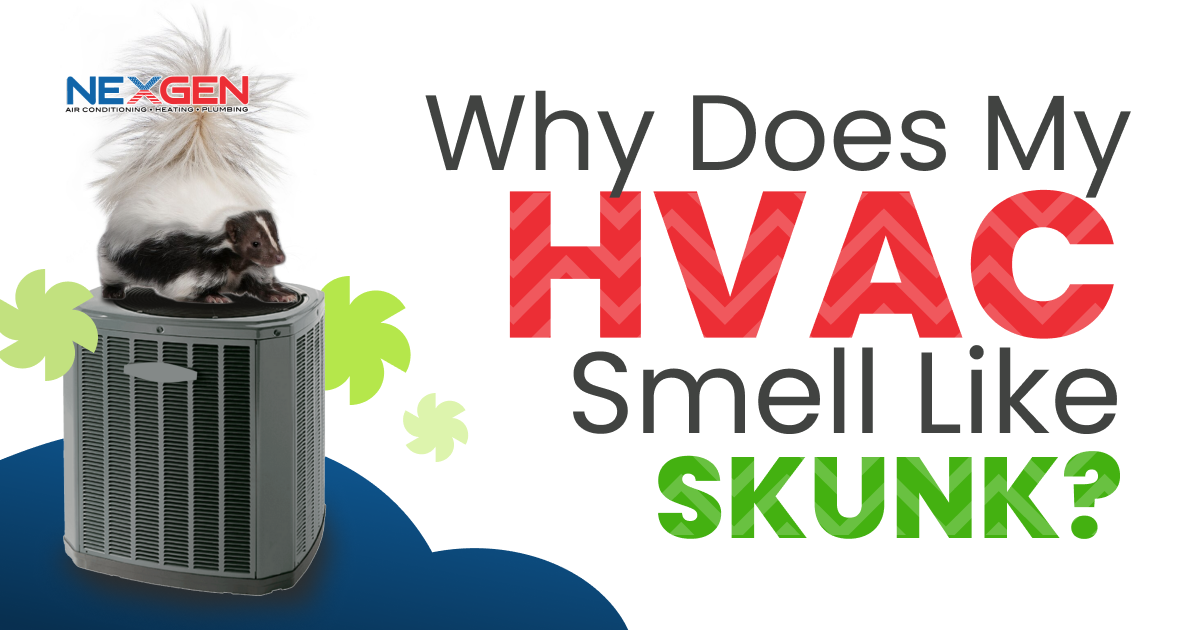
Every HVAC problem invokes a sense of dread. Is it something minor, or will you spend hundreds or even thousands of dollars on repairs? Foul odors usually mean big problems. If your HVAC smells like skunk, the source may or may not be rodents, but there’s no doubt a professional should check it out.
A strong, unpleasant odor may suddenly occur for the following reasons:
Rodent Infestation
Small rodents and other animals like nesting in sheltered places. Crawl spaces and air ducts are ideal for them, especially if there’s a food source nearby. An infestation in these places can release particles, odors, and viruses into the air that circulates throughout your home.
To investigate whether you have an infestation in your HVAC system, remove the vent covers and look for signs of animal activity. Hair, food particles, and droppings are telltale signs. If the scent is coming from that area, it will be stronger when you remove the vent cover. Also, check for damage to your home’s foundation and exterior.
If one or both of these issues are present, call an exterminator and someone to clean out your HVAC system.
A Skunk Did Spray Outside Your Home
If your HVAC smells like skunk, one may have sprayed nearby, and the odor may be detectable inside. It can also reach your AC system and propagate through your ductwork. If you can determine that a skunk is outside and probably sprayed, turn off the AC until the smell dissipates. The odor should go away once you turn it on again.
Gas Leak
A skunk odor in your home should be taken seriously because of the potential for a gas leak, especially if you have a furnace or other gas appliances. Although a gas leak usually smells like rotten eggs or sulfur, methyl mercaptan (what gas companies add to make gas leaks detectable) can smell like skunk spray to some people. Natural gas is otherwise odorless but very dangerous.
If you can’t find any other source of the skunk smell, evacuate your home and call for help. The gas can make you sick and carbon monoxide may be present.
Sewer Gas
It’s not hard to confuse the smell of natural gas and sewer gas. Originating from your sanitary sewer line or septic system, these odors are created by methane combined with hydrogen sulfide and other gases. Hydrogen sulfide is produced as plant and animal materials decompose.
One way to deal with a sewer gas odor is to run a rarely-used faucet. The drain may have dried out, allowing sewer gas to back up. Letting the water run can stop this from happening. If your HVAC smells like skunk, check for underutilized plumbing fixtures. If running a faucet doesn’t fix the issue, there may be a broken drain line or clogged pipe.
Therefore, a skunk odor can be caused by an HVAC or plumbing problem, so you’ll need a professional to determine the source.
Call NexGen If Your HVAC Smells Like Skunk
Our HVAC professionals can provide AC repair and maintenance if a skunk odor is in your home. They can also determine if the issue is coming from your plumbing or sewer lines, or if there’s a potential gas leak. We can fix your air conditioning system, repair plumbing (including gas lines), and clean drains as necessary. Affordable, low-interest financing is available upon approved credit. Call (833) 729-9735 to learn more or schedule service.
What To Do If There's No Power to the HVAC Control Board
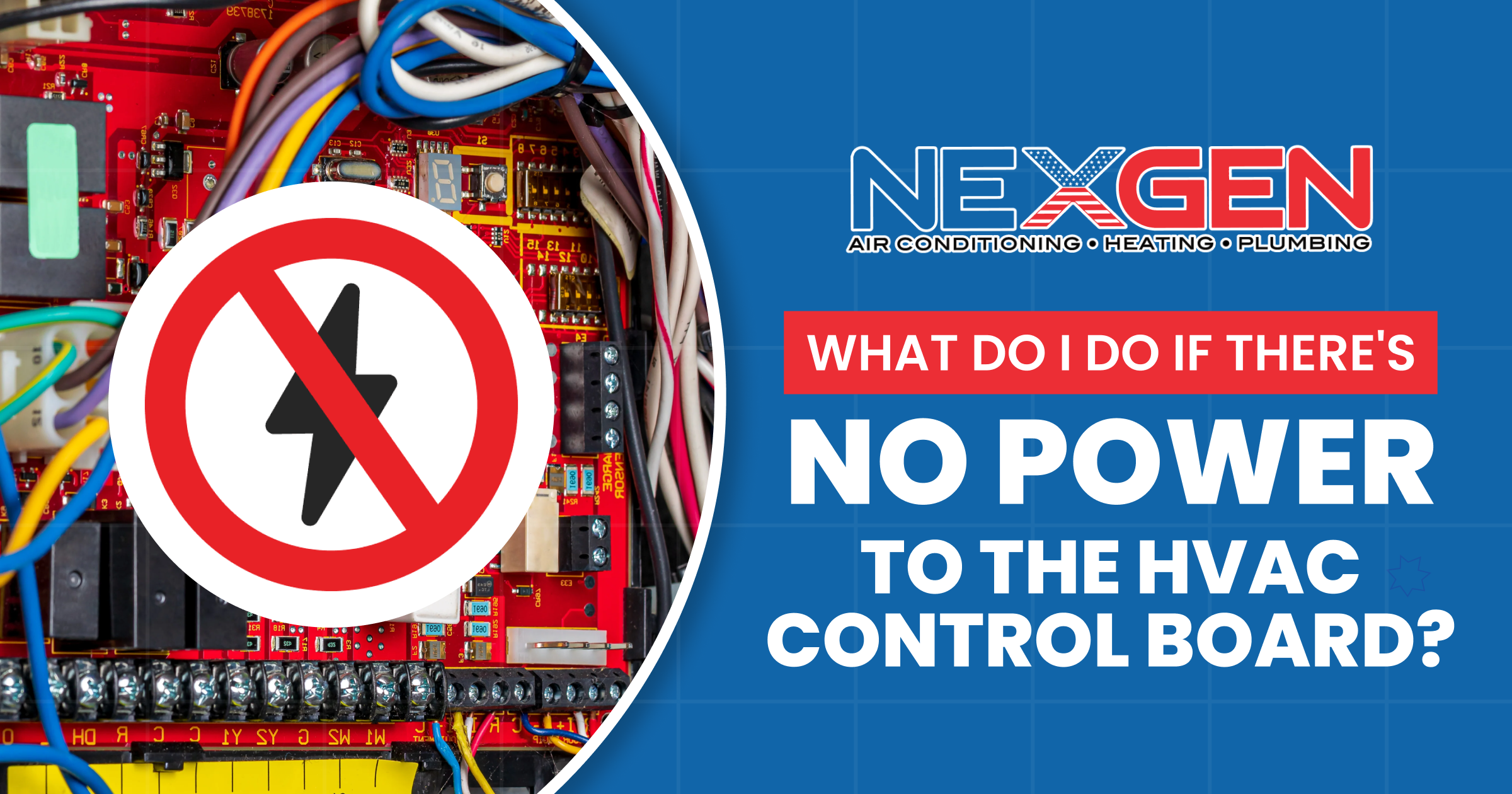
The AC unit, air handler, and furnace are familiar parts of your HVAC system. However, the control board isn’t something you often interact with. If it’s not working, it can’t command any part of your heating or cooling system to operate correctly. We’ll explain what it is, how it works, and what to do if there’s no power to the HVAC control board.
What’s an HVAC Control Board?
The control board is essentially the system’s command center. Input from the thermostat is received by the board, which then relays the appropriate commands to your furnace or air conditioner. A furnace circuit board regulates the ignition, gas valves, flame sensor, blower motor, and other components. A defrost control board works similarly, except it monitors for the buildup of ice and triggers the defrost function when it’s needed.
How to Check the Control Board
First, you’ll need your furnace’s manual, which should show the location and setup of the control board. Before starting, you’ll also need a screwdriver, electrical tape, and a voltage meter. Proceed with the following steps if there’s no power to the HVAC control board:
- Remove the Access Panel: Open the panel, using electrical tape to hold it open. Locate the control board, which is often at the bottom near the blower.
- Check for Damage: If there’s physical damage such as faulty wires or burn marks on the board, it’ll have to be replaced.
- Use Your Senses: Do you hear buzzing sounds? Are there burning or other strange odors? If so, call a professional right away.
- Check the Diagnostics: Look at the diagnostic light on the control board. If it’s not on, the board isn’t powered; if the light is blinking, count the blinks and refer to the manual to determine the problem.
- Test the Power: Check for a door switch on your furnace or HVAC unit; tape it down to prevent any electrical accidents. Using a voltage meter, test the common wire from the transformer to the board. The meter should read 120 volts AC. If not, the board should be replaced.
- Check the Terminals: One last step before replacing the control board is to test the thermostat terminals. After turning the system off, reconnect wires to test each terminal, turning the unit on and off in between tests. With the R and G terminals connected, the blower should activate; connecting the R and W terminals should trigger the heater while connecting the R and Y terminals should turn on the AC. These responses are assuming the control board is powered and functioning.
How Do I Know There’s a Control Board Problem?
If the control board isn’t working, there may be issues with temperature regulation. The symptoms are often similar to those associated with other problems, such as blower fan, power, or filter issues. If your HVAC has warning lights or diagnostic codes, you might see a notification of an unpowered or failing control board. However, the system may not work at all if the control board isn’t powered.
Why Does an HVAC Control Board Fail?
The control board should last the life of your HVAC system. But high temperatures, numerous heating and cooling cycles, or wiring issues can wear it out. A single faulty transistor or relay on the board can result in a malfunction. Sometimes a faulty transformer or fuse is the cause; a technician can provide replacement components to fix the problem. If the board is damaged, usually the only option is to replace it, which requires a professional to handle wiring and installation work.
Call NexGen If There’s No Power to the HVAC Control Board
Customers throughout Southern California rely on NexGen for all types of heating and AC repair. If you have temperature control, airflow, or power problem or need an HVAC control board replaced, our licensed technicians will get your system running again in no time. They are fully licensed and insured. You can reach us 24/7 by calling (833) 729-9735.
Ways to Protect Your HVAC & Plumbing Systems from Heavy Rain
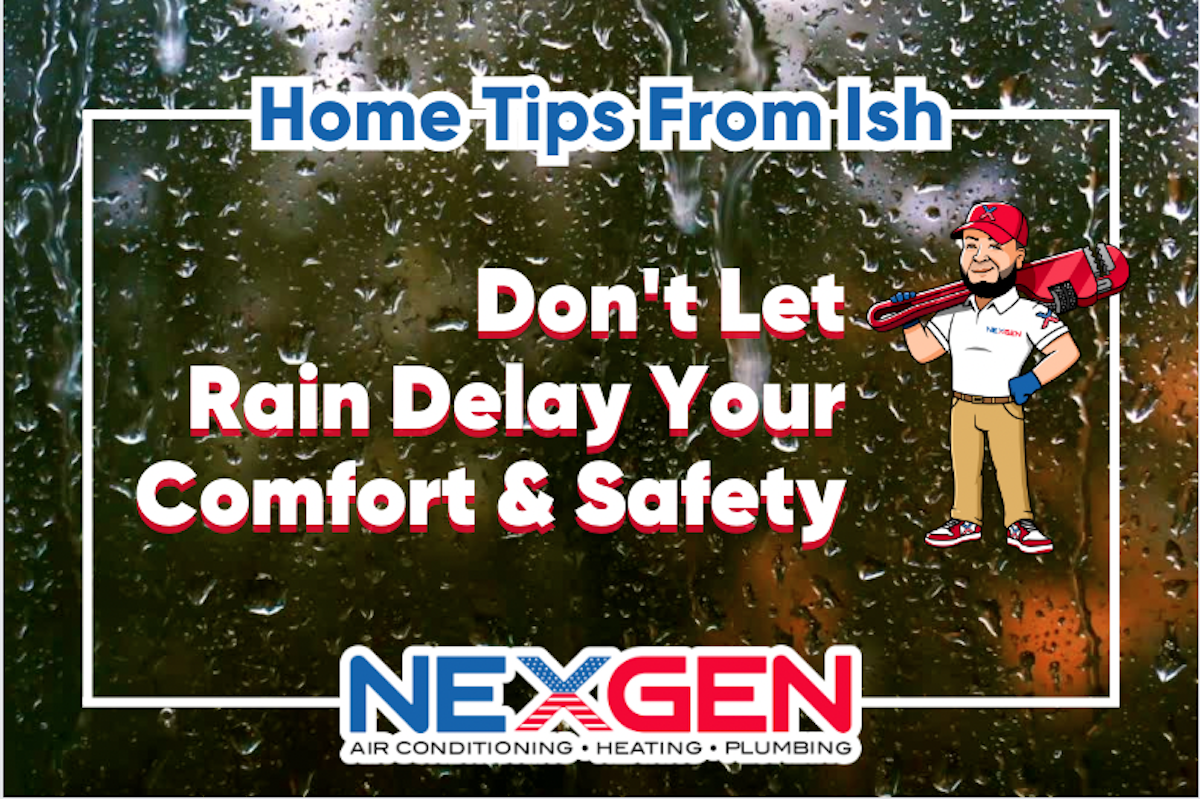
California has endured years of drought, but the past few months have brought one rainstorm after another. Repeated deluges have ended water restrictions for many in Southern California. But the atmospheric rivers that keep pummeling the state can do a number on home HVAC and plumbing systems. We’ll look at a few ways to protect your home from the effects of so much rain.
Ways to Protect Your HVAC System from Heavy Rain
Water can cause serious damage to your HVAC system. Air conditioners are designed to drain condensation, but their components are extremely sensitive to water exposure. The wind is also a problem as it can blow debris onto and into the condenser unit. Fortunately, there are easy ways to protect the system:
Cover the HVAC Unit
If you haven’t covered the AC unit with plywood for winter, place a plywood sheet over the top. It is effective at shielding the unit from snow and ice. If your area doesn’t see much snow, you can cover the unit with a tarp to shield it from rain and strong winds. Strap the tarp on so it doesn’t blow away. Fitting a metal or plywood cage around the air conditioner is also an option. It protects against flying debris.
Secure the Area Surrounding the Unit
Before a storm, trim trees, branches, and shrubs so they can’t fall on the AC unit. You can also plant shrubs nearby to block the wind. Exposed wires should be covered to prevent water exposure and damage from falling objects. The unit should also be anchored to a concrete pad next to a concrete or stone wall, and any loose objects nearby (toys, firewood, outdoor furniture, etc.) should be moved inside.
Install Hail Guards
Thick metal mesh hail guards should be installed before a storm hits. They don’t interfere with the unit’s heating or cooling abilities. And you avoid the unit being riddled with dents, bent fins, or damage to the coils that can prevent it from keeping your home comfortable.
Ways to Protect Your Plumbing System from Heavy Rain
Ironically, your plumbing system, which is designed to carry water, can be heavily damaged by it. Rainstorms pose an especially high risk for drains, as sediment and debris can easily clog them. Underground plumbing is also susceptible to damage by heavy wet soil and standing water. Here are some steps you can take to protect your plumbing:
Improve and Maintain Outdoor Drainage
Excessive rainwater can flood your driveway, yard, or deck and even compromise your home’s foundation. Install drains at low points on your property. And check them often for debris to clear away. Use a wet-dry vacuum to pull out debris if necessary, or install a drain guard to prevent dirt, leaves, rocks, and other items from causing blockages. Also, make sure gutters and downspouts are clear and properly installed.
Know the Signs of a Drain Problem
If your toilet starts gurgling during heavy rain, a drain is likely clogged or backing up. Your toilet may back up if rainwater has gotten into a septic tank. Clogged drains can affect municipal sewer lines as well. When this happens, dirty water can accumulate in drains and cause pipes to crack or burst. If your water looks dirty, tastes coppery, or smells like mildew or something worse, call a plumber right away.
Maintain Your Sump Pump
Sump pumps remove water from basements or the lowest part of your home. If you have a sump pump, it should turn on automatically when water reaches a certain level. At least once a year, pour some water into the sump pump basin to make sure it’s working. If it doesn’t turn on, call a plumber to inspect and repair it before the rain arrives. It will save you from a messy cleanup later on.
Call NexGen for HVAC/Plumbing Service
Whether you need AC repair or a plumber in an emergency, you can count on NexGen for prompt, effective solutions. Recent storms in California have affected many homeowners. Be on the alert for air conditioning or plumbing issues and reach out to us as soon as anything seems awry. We’ll provide repairs, drain cleaning, and inspections and address any mold or indoor air quality issues caused by recent rains. To get started, book your appointment online or call (833) 729-9735.
Top 10 Heater Allergy Symptoms

A central heating system will keep your home warm and cozy all winter if it’s working properly. Even so, it can still have issues. Heater allergy symptoms that appear when your HVAC system is running mean dust, pollen, mold, pet dander, and other allergens (and possibly toxic compounds) are in your heating system, ductwork, and indoor air.
However, your symptoms may disappear when the heater is turned off or you leave your home. To help you recognize the signs of an issue, here are the top 10 heater allergy symptoms to look for.
- Aggravated Respiratory Illnesses: If you have asthma, severe allergies, or other respiratory issues, a contaminated heating system can worsen your symptoms. It can trigger asthma attacks that can last longer than usual.
- Sinus Infections: Contaminants from air ducts and indoor spaces enter your nasal passages every time you breathe. They can be drawn up into your sinuses and cause inflammation. Sinusitis can be painful and have a variety of effects unless it is properly treated.
- Sneezing: Sneezing is a way to get rid of irritants. In the case of heater allergy symptoms, it’s due to airborne particulates and is often accompanied by sinus congestion.
- Coughing: Particulates and allergens can make their way into your throat and cause dryness. When combined with the presence of irritants, this can cause a great deal of discomfort.
- Sore Throat: The dryness of the air can trigger a sore throat. The irritants in the air don’t help, and neither do bacteria that can remain suspended and cause infections when breathed in.
- Headaches: Sinus headaches and migraines can be triggered by clogged sinuses. The odor from dust, mold, or fungus can cause a headache as well. It’s also one of the symptoms that your furnace may be releasing carbon monoxide.
- Watery/Itchy Eyes: Dusty air can cause your eyes to feel itchy and become teary.
- Fatigue: Persistent exposure to allergens can often leave you feeling tired, fatigued, or sleepy. You may feel dizzy at times as well.
- Nausea/Vomiting: Tiny particles aren’t the only things your heater can release. Volatile organic compounds, or VOCs, include toxic chemicals that can make you feel sick.
- Skin Rashes: Various types of skin rashes can be caused by VOCs as well. Many VOCs evaporate at room temperature. However, some do so more slowly in colder temperatures, which is why dust may hold more allergens in the winter.
Why Winter Makes You More Vulnerable to Heater Allergy Symptoms
Allergy symptoms don’t only occur because your heater is running. Dust also becomes harder to filter out. When it’s warmer, air tends to hold more moisture, making it easier for particles to stick together and fall to surfaces, where dust forms a coating. In colder, less humid air, dust particles tend to stay apart and remain in the air longer. Since they’re smaller, they can easily slip through air filters.
Meanwhile, breathing in dry air can make you more susceptible to allergies. That’s because mucus catches pollutants and protects your body against them. Dry mucus linings and sinuses don’t catch allergens, bacteria, and viruses as effectively. Heater allergy symptoms are your body’s reactions to this constant exposure. Infections can become more frequent as well.
NexGen Can Help Alleviate Your Heater Allergy Symptoms
NexGen installs and services high-quality HVAC equipment and also provides duct cleaning, air duct sealing, and insulation services to help reduce allergens and improve energy efficiency. We also offer comprehensive maintenance services as part of our X Protection Plan. It includes priority service, HVAC tune-ups, and discounts on indoor air quality products. Therefore, you can depend on our team to help protect your home, your comfort, and your health. To get started, call 833-729-9735 today.
What Are the Latest California HVAC Regulations?

New California HVAC regulations are targeting refrigerant use and efficiency. This is not the first wave of changes in the industry. In 2013, Title 24 efficiency standards were set by the California Energy Commission; in 2016 the California Air Resources Board (CARB) was authorized to oversee the reduction of hydrofluorocarbon (HFC) emissions. Even more sweeping regulatory changes will take effect in 2023.
The U.S. Department of Energy has strictly regulated minimum efficiency levels for HVAC equipment since 1992. All air conditioning systems are measured using the seasonal energy efficiency ratio (SEER). Meanwhile, the heating seasonal performance factor (HSPF) is used for heat pumps and annual fuel utilization efficiency (AFUE) is used for furnaces.
New Restrictions on Refrigerant
California passed legislation in 2018 that banned high global warming potential (GWP) HFCs, mirroring previous federal bans. California HVAC regulations announced in 2022 require:
- Equipment with over 50 pounds of refrigerant to use coolant with a GWP of less than 150. Per the California Air Resources Board (CARB), this is expected to cut emissions by over 90% in facilities such as supermarkets and industrial buildings.
- Food retailers with 20 or more stores to maintain a weighted average refrigerant GWP of less than 2,500, or reduce GWP potential by at least 25%, by 2026. By 2030, all stores would have to reduce their average GWP by 55%.
- New systems for industrial refrigeration, in existing non-retail facilities, can use refrigerants between 1,500 and 2,200 GWP.
- For new room air conditioners and dehumidifiers, the refrigerant used must have a GWP of below 750, beginning in 2023. Larger stationary ACs have until 2025 to meet this requirement.
- CARB will launch a Refrigerant Recovery, Recycle, and Reuse Program in which AC manufacturers would have to use 10% of recovered R410 refrigerant from retired systems.
Nationwide Guidelines Also Apply
The Department of Energy (DOE) has made changes that will impact the entire nation. In the southwestern region, which includes California, the minimum standard SEER rating for cooling systems will be increased to 15 SEER (for split units using less than 45,000 BTU) and 14.5 SEER (for units that use more than 45,000 BTU). New EER/EER2 requirements will also go into effect. In all regions, furnaces must have at least an 81% AFUE rating and air-source heat pumps must have a minimum heating efficiency of 8.8 HSPF.
According to Angi, the increased efficiency requirements can mean paying $350 to $1,500 more for a new air conditioner, heat pump, or packaged system.2 But higher efficiency can mean saving on heating/cooling bills each month. After all, heating and cooling account for 55% of the energy used in homes, based on numbers by the Office of Energy Efficiency and Renewable Energy.
The 2019 Building Energy Efficiency Standards
These changes included requirements for fan efficiency in forced air systems; for gas furnace air-handling units, fans must operate at 0.45 watts/cubic feet per minute (CFM) or less. For non-gas air-handling units, it is 0.58 watts/CFM. Meanwhile, small duct, high-velocity forced-air systems must have fans running at 0.62 watts/CFM or less (with an airflow requirement of 250 CFM /ton or greater).
Porous inner core flex ducts are required as well. The exception is if there’s a nonporous layer or air barrier between the duct’s inner layer and outer vapor barrier. Mandatory air filtration requirements for systems with 10 feet or more of duct were set as well, with filtration being required on supply and balanced mechanical ventilation systems.
Title 24 Compliance Still Applies
The Energy Commission’s 2013 Title 24 rules still apply. These are minimum efficiency standards intended to reduce energy consumption throughout the state and include requirements such as:
- Duct Testing: Unless ductwork is entirely enclosed within a conditioned space, it’s required to be sealed and insulated. Ducts must be insulated by material with an R-8 or R-11 value, while leakage must be HERS verified by a third-party licensed inspector/rater. Pressure tests are required everywhere in California and ductwork must be examined/repaired to pass an inspection.
*If no ducts are replaced, there must be 15% or less leakage; if ductwork replacement is performed, leakage must not exceed 6%).
- HVAC Sizing: Before installing HVAC equipment, the heating and cooling load of a project must be properly calculated to ensure lasting efficiency. However, state requirements do not set rules as to the actual size of any piece of heating or cooling equipment.
- Smart Thermostats: Title 24 requires smart thermostats with features like programmability and automatic setbacks. This pertains to the installation of central heating/cooling systems during construction. There are no specific requirements for how occupants use their thermostat’s programmable settings.
NexGen Factors the Latest Regulations into New System Design
At NexGen, we supply and install the latest, most efficient HVAC equipment including traditional, electric, rooftop, and ductless systems. Our licensed technicians are fully trained in the most recent California HVAC regulations plus the newest products, tools, and methods. Our expertise and commitment to customer satisfaction make us the leading HVAC company in Southern California. To learn more about our equipment, services, and protection plan, book an appointment online or call 833-729-9735.
How Are Your HVAC and Plumbing Systems Connected?
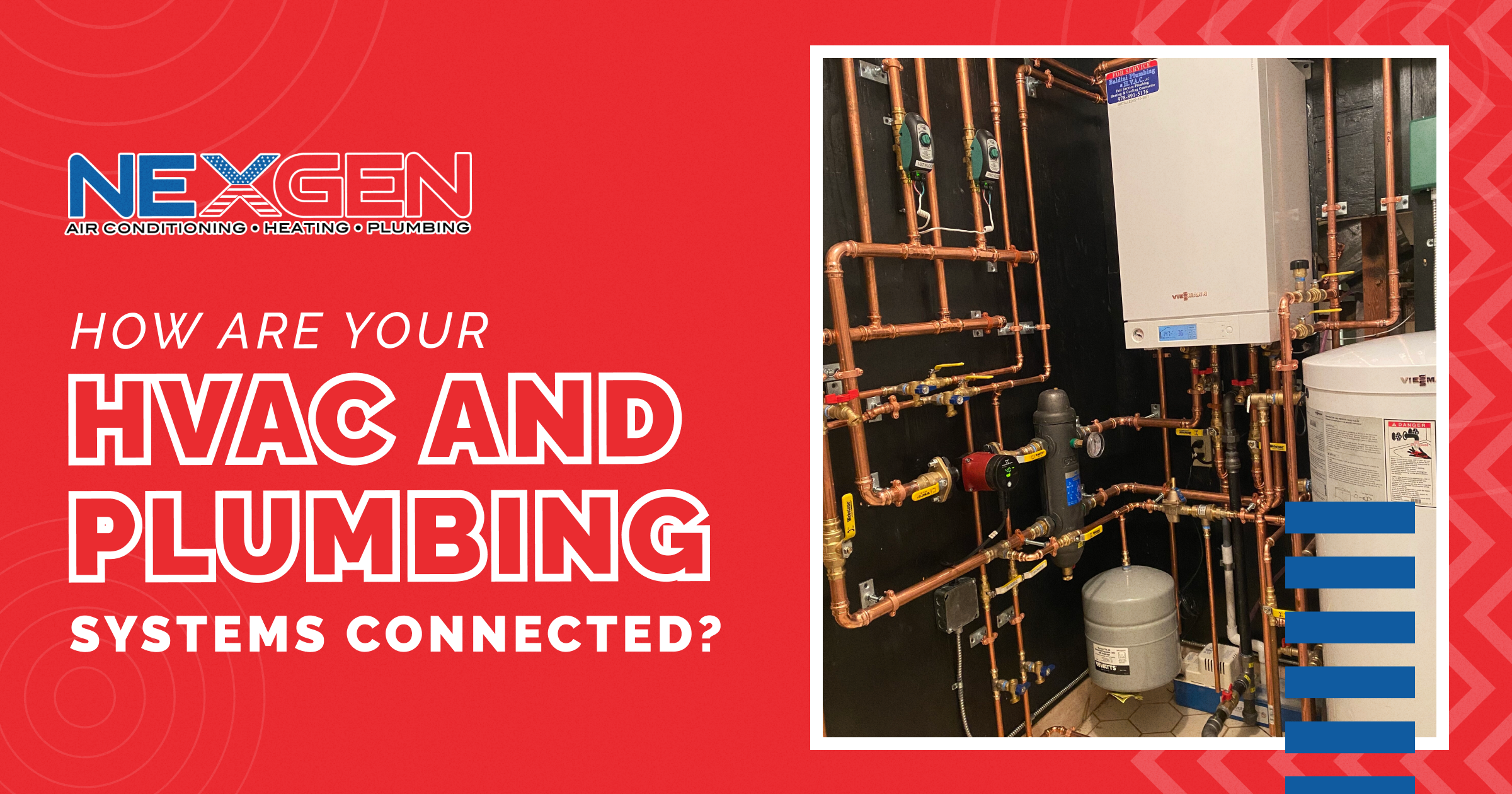
Air conditioning (HVAC), and plumbing (which involves water supply/drainage lines and connected fixtures), are two separate systems. Most people don’t realize there’s any connection between them. However, HVAC and plumbing do interact, meaning the performance of one can affect the other.
Your Central AC System Has a Drainage Line
The drainage line for your HVAC system is the most common interaction point between it and your plumbing. It collects condensate from humidity (via the condensate pan under the indoor air handler). In some systems, the condensate drainage line delivers water directly to the sewer line. But usually, condensation drains via a line through an exterior wall and to the ground. The line may also be plumbed into an upstairs sink or another part of your plumbing system.
The following issues can arise due to HVAC/plumbing drainage issues:
- For systems connected to the sewer main, a sewer line problem can cause condensation to back up, leading to water on the floor or a ceiling. Water can also potentially damage AC components.
- Water damage can occur to flooring, walls, interior ceilings, baseboards, and other elements of your home.
- Mold and/or mildew can start to grow, and then spread in colonies or through the air especially if it gets inside your HVAC system.
A condensate drain can also become clogged. This problem can be identified when you don’t see the drain dripping when the AC is on. If the condensate line and a different part of your plumbing system are both clogged, a backup can occur. For example, if the HVAC condensate drain is tied to a sink, that sink may start draining slowly.
While the condensate drain can be cleaned by pouring a half-cup of vinegar into it, don’t attempt this too often. If the drain continues to clog up, have an HVAC technician look at it. Another issue is when there’s drainage and your air conditioner is not running.
Inadequate Heating Can Impact Your Plumbing
A compressor problem, low refrigerant, or poor maintenance (leading to dirty coils, clogged filters, etc.) can affect HVAC performance. Your heating system plays a role in keeping your plumbing warm as it does the interior of rooms. If it gets cold enough in your home, pipes could potentially freeze during the winter (especially if they’re installed within exterior walls).
However, a more common issue is when the pipes in your AC system freeze. Since plumbing does not provide ventilation, it’s not going to help HVAC components warm up. If it’s too cold, pipes will continue to freeze and potentially crack and fail.
Often made of PVC tubing, condensation lines are prone to the same issues as water supply lines. They can be affected by cracks, broken joints, and ruptures. The effect is more subtle since the contents of an HVAC condensate line aren’t under pressure. Water exits a damaged line slowly and signs of an issue may develop incrementally over time.
HVAC and Plumbing Systems Both Need Maintenance and Professional Care
Different licensing and certifications are required to service either an HVAC or plumbing system. Air conditioning and heating systems need maintenance at least once or twice a year. Their mechanical nature means they’re highly prone to wear. But plumbing is always in high demand as well, and the presence of water means corrosion, clogs, or limescale can develop. A plumbing or HVAC failure can be costly to resolve. And, both are critically important to the function, comfort, and safety of your home.
Contact NexGen for HVAC/Plumbing Service
We specialize in residential and commercial HVAC and plumbing services. Customers throughout Southern California can depend on us for 24/7 emergency service and heating, air conditioning, and plumbing installation, repair, and maintenance. To get started, book an appointment online or call 833-729-9735 today.
Should I Avoid the Cheapest AC Installation?
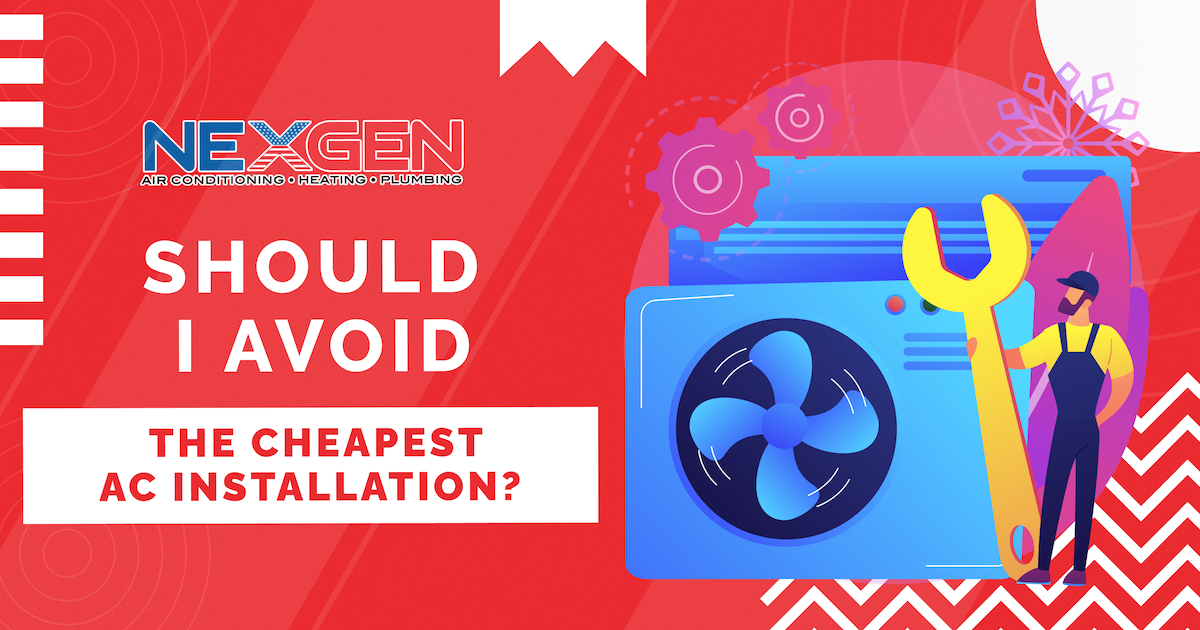
It can cost $10,000 or more to install a central air conditioning system in an average home. For most of us, saving money is a priority. But going for the cheapest AC installation can actually cost you more in the long run. In doing so, you risk:
Purchasing Low-Quality Equipment
Some brands are just more expensive than others, but cheap installation often sacrifices quality. The less you spend on an air conditioner, the less reliable and efficient it may be. You also might not get the features and options you need. You may pay higher electric bills and for repairs sooner than you would with a higher-end system. There’s also a risk that too small an AC will be installed, which will struggle to keep your home cool.
Poor Installation Service
HVAC companies that charge significant labor rates are generally committed to getting the job done right. A poor AC installation can mean the unit won’t keep up with your cooling needs, temperatures may vary from room to room, and your home may be too humid. Improperly installed air conditioners also cannot run as efficiently, so you end up paying higher utility bills. Aside from finding a reputable contractor, you want to make sure discounts or savings don’t equate to shortcuts.
Vague Service Proposals
A contractor’s proposal should itemize everything the service includes. Get every quote in writing and after the contractor inspects your home. A lowball price over the phone means nothing, as they won’t fully understand your needs or even do a load calculation first. The company should generously match a competitor’s price, but first, compare previous proposals you received. Allowing them to perform AC installation can mean dealing with discomfort, wasted energy, and poor air quality for years.
Incompatible Equipment
Replacing only the indoor or the outdoor unit can mean spending a lot more later. You won’t see efficiency benefits by combining a more modern unit with an older one. If the components are incompatible, the results can include reduced performance and comfort and strain that leads to major damage. Your best bet is to replace all HVAC components at once to ensure fewer problems and pay for only one installation visit.
Inexperienced Contractors
An AC contractor that charges cheap rates may not have the proper skills or licensing. It’s not cheap to obtain a state license, so a reputable installer must cover some of these costs. Additional training is needed to obtain North American Technician Excellence (NATE) certification and become a factory-authorized dealer. All these require a high level of expertise. It’s also important a contractor is insured; cheap service is an indicator they may not be.
If the quoted price is too good to be true, it probably is. There’s often a reason an HVAC contractor would charge such a low price, such as a history of bad reviews and poor installation service.
Is It Ever Okay to Save on AC Installation?
You can achieve savings and preserve quality by taking advantage of seasonal discounts, manufacturer’s rebates, and tax credits. When you get quotes from different contractors, compare what’s included in each to find the most value. Also, schedule AC installation for the spring and fall, when there’s less demand off-season. Generally, paying a fair price often means having a system that meets your needs and is affordable to operate.
So, the answer is, you should avoid the cheapest AC installation. There are safe ways to reduce the initial cost, but you can find opportunities to save later. These include changing your AC filters often, maintaining a constant temperature, and scheduling regular preventative maintenance when the manufacturer and contractor recommend it.
Contact NexGen for High-Quality AC Installation
The #1 HVAC company in Southern California, NexGen offers high-quality AC equipment including traditional, electric, rooftop, and ductless units. We also supply and install air purification systems and the latest thermostats. Our team of experienced AC installers ensures 100% success with each job, while free estimates, financing, and a membership maintenance plan help make our exceptional service affordable.
To schedule a free estimate and evaluation, call NexGen at 833-729-9735 today.
Ultimate Outdoor Air Conditioning Buying Guide
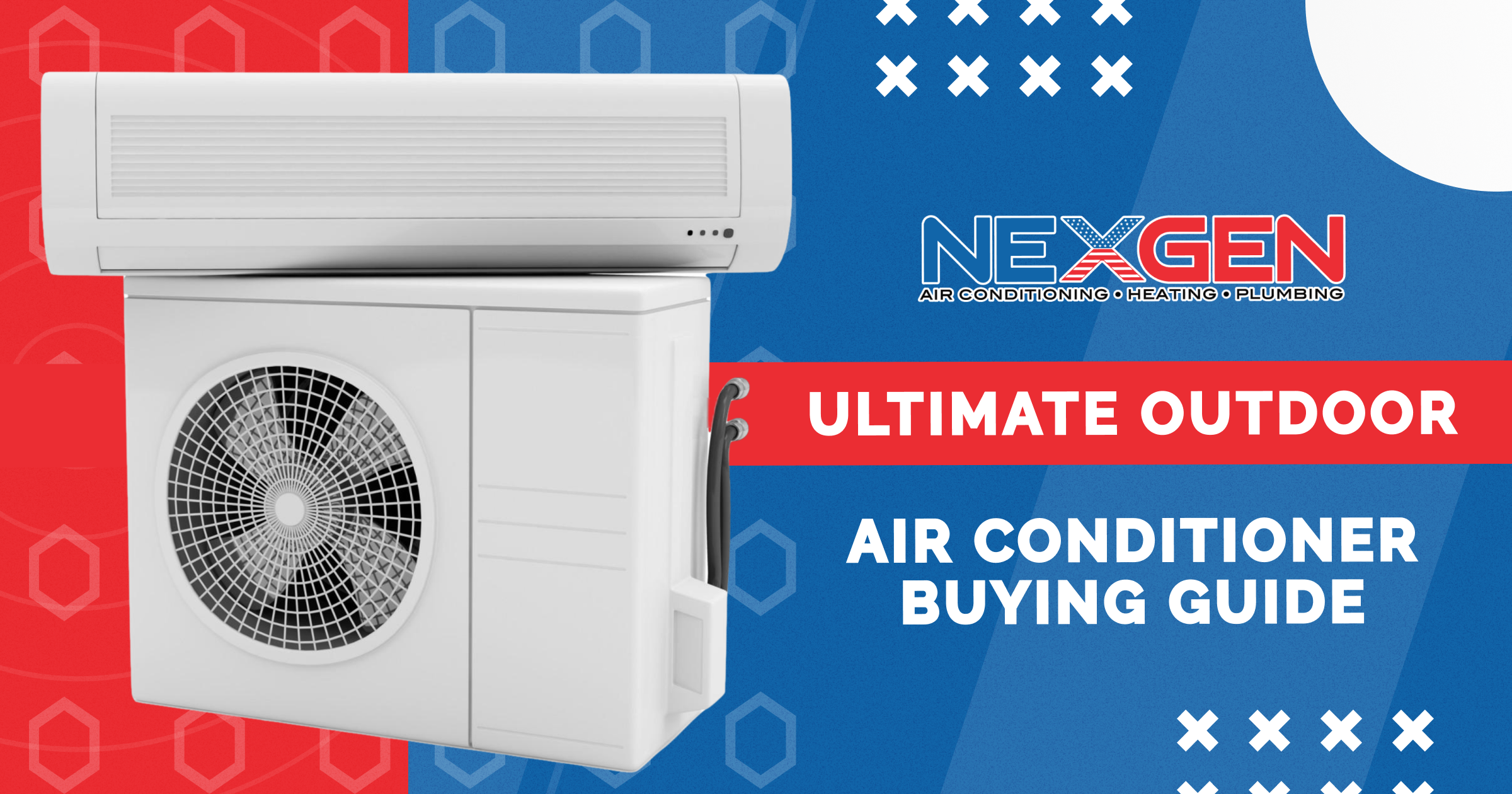
The outdoor air conditioner unit is an important part of your HVAC system. Containing the condenser coil, compressor, and fan, an outdoor unit releases heat absorbed from indoor air. But how do you choose an outdoor unit? It generally should match the brand and type of indoor air handler unit you have. In this buying guide, we’ll cover a few important considerations in selecting an outdoor air conditioner.
Types of Outdoor Air Conditioner Units
For a central air conditioning system, you’ll probably have one of two types of units. These are:
- Split-System Units: The outdoor cabinet includes the fan, compressor, and heat exchanger components, while the indoor cabinet has a heat exchanger and blower. It may also contain the furnace. A heat pump’s heat exchanger may be built into the indoor cabinet as well.
- Packaged Units: All major components are contained within a single unit, often placed on the roof (but sometimes near the foundation). A packaged unit can integrate a natural gas furnace or electric heating coils. It connects directly with supply and return ducts to deliver conditioned air and cycle it back through the system.
Choosing an Air Conditioner: Considerations
It’s unwise and impractical to choose just any air conditioner. For it to meet your needs and function properly, you need to think about:
- Size: Outdoor air conditioners are sized according to British Thermal Units (BTUs). The greater the square footage of your home, the more BTUs you’ll need. A one-ton AC outputs 12,000 BTUs per hour, so for a 2,000-square-foot home requiring a 3.5-ton system, you’d need a 42,000 BTU air conditioner. But the capacity you need is also affected by direct sunlight, the number of occupants, and heat-producing appliances.
- Efficiency: A high-efficiency air conditioner may cost you more upfront, but can save you money over time by using less electricity. The Seasonal Energy Efficiency Rating (SEER), listed on the unit’s Energy Guide® label, tells you how efficient it is. An air conditioner must be rated at least 13 SEER. Highly efficient units are rated from 15 to 17 SEER.
- Modern air conditioners also have energy-saving features like larger coils, allowing for more efficient heat transfer. Variable-speed blowers adjust to demand to reduce electricity consumption, while a fan-only switch lets you run the fan to achieve cooling without running the AC. An automatic delay fan switch lets the fan run long enough to allow residual cooling. Since a clear filter boosts efficiency, a filter indicator light to alert you that maintenance is needed helps.
- Location: Installing an outdoor air conditioner in the correct location is important. The unit should be installed where there’s enough room for proper airflow and for technicians to perform maintenance and repairs. Outdoor condenser units can be noisy, so you should pick a place where they won’t disturb neighbors or the occupants of your home.
Cost of Outdoor Air Conditioners
A central air conditioning system can cost from $3,000 to $7,000 to install. It’s usually not only the outdoor unit you need to install or replace. You need to factor in the cost of indoor air handlers, furnaces, ducts, and more as well as labor. A larger, more complex system can cost $20,000 or more.
Warranty
Make sure you fully understand the terms of the manufacturer’s warranty and what is covered. Some warranties provide different coverage for the unit and certain parts. Others may only cover labor for certain types of work. Neglecting to maintain the AC or having a non-authorized individual service it can void the warranty, so it’s important to understand all the terms and conditions.
Have NexGen Install Your Next Outdoor Air Conditioner
At NexGen, we supply and install high-quality, high-efficiency air conditioners and HVAC equipment. We specialize in all leading brands. Our licensed, insured technicians will help determine the right unit for your home to provide the update you need. In addition, comprehensive warranties and maintenance plans are available. For more information, call 833-729-9735 today.
Why Is My AC Spitting Ice?
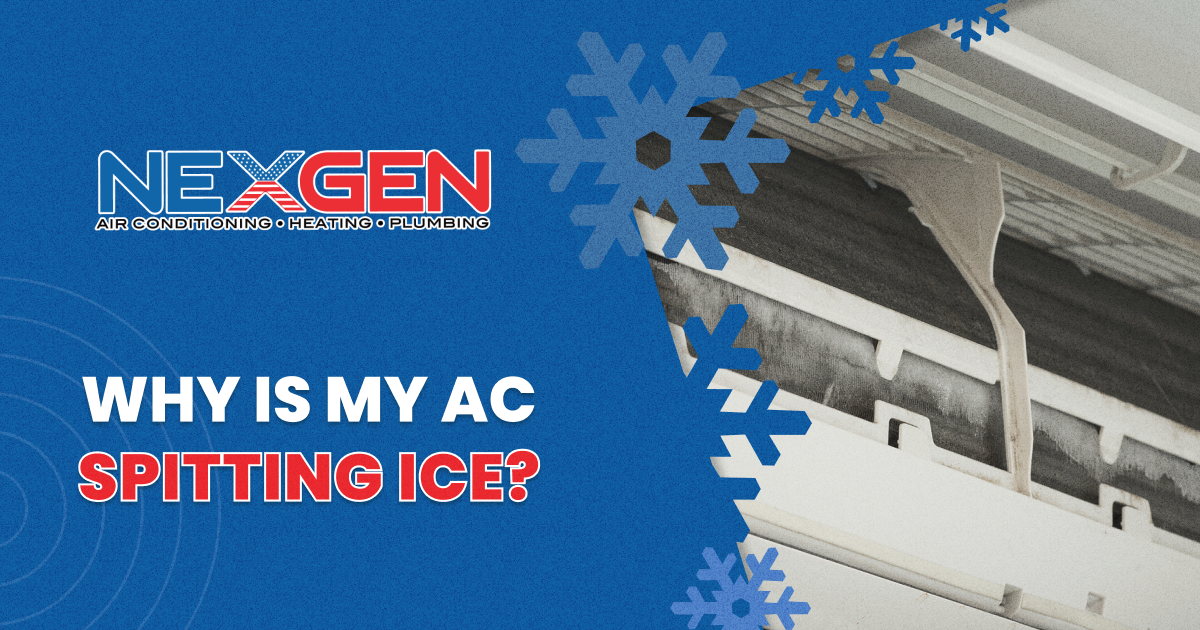
If your air conditioner is spitting out ice, the evaporator or condenser coils are probably frozen. Allowing your AC to continue running can cause serious damage, or at the very least accelerate wear. There are a few answers to the question, “Why is my AC spitting ice?” We will list a few below to help you troubleshoot the issue and know whether you need an HVAC technician’s help.
The Outside Temperature Has Dropped Below 62℉
An air conditioner is designed to keep your home cooler than the outside air temperature. It’s unlikely you’d want it to be colder than 62℉ indoors. If the AC is running full blast, this can cause the temperature around the evaporator coil to fall below freezing. Any condensation or moisture present will freeze on contact. When the outside temperature falls, run the AC in fan mode or turn the system off and use a ceiling fan or open a window.
Refrigerant Is Low and/or Leaking
If your AC is spitting ice and you hear a hissing sound, there’s likely a refrigerant leak. Only a trained technician can fix the problem. The coolant in your AC runs through a closed system. It should never be low. If it is, there will be serious temperature regulation problems in the system and components can easily freeze.
The AC Filter Is Dirty
A filter helps keep the air clean, but your air conditioner will run without it. However, when the filter gets dirty or clogged, it’s a different story. A clogged filter reduces airflow. Without enough air passing through them, the coils get colder causing ice to form. To avoid filter issues, replace it every three to six months.
The Evaporator Coil Is Dirty
When the evaporator coil is coated in dirt, it won’t allow for effective heat transfer. Warm air may never reach the coils. As a result, they get colder, and frost forms on the surface. Some of this ice can break loose in the airflow and get flung out of the AC vents.
Clogged Condensate Drain
The AC can spit water if the drain is clogged with dirt, mold, or algae. Moisture regularly condensates in an AC system; this is what the drip pan is for. It collects condensate so it can be evacuated via a drain. If the drain isn’t functioning, water can leak from the unit and performance can be affected. The coils may eventually freeze if the issue isn’t fixed.
The Fan Is Not Working Properly
Insufficient airflow can cause the coil to get cold and freeze, resulting in ice spitting from the AC. This may be due to a faulty fan motor, which can occur due to mechanical or electrical issues. The fan can become loose or break as well. Repairing or replacing an AC fan requires technical expertise.
How Do I Thaw Out My Air Conditioner?
You can thaw out the unit by running it in fan mode. The ice should start to break down soon after. You might also want to leave the system off, although the process may take five or more hours to complete. During that time, install a new filter just to be on the safe side.
Contact NexGen for Air Conditioning Repair
When customers ask us “Why is my AC spitting ice?”, there can be several answers. Depending on the problem, you may need the system inspected to determine whether any types of AC repair are needed. Google Certified for Home Services, we fix any air conditioning problem for clients in Southern California. For service by knowledgeable, experienced, and background-checked technicians, call 833-729-9735 today.


















